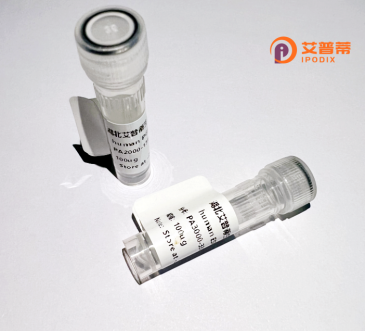
| 纯度 | >90%SDS-PAGE. |
| 种属 | Human |
| 靶点 | C3orf10 |
| Uniprot No | Q8WUW1 |
| 内毒素 | < 0.01EU/μg |
| 表达宿主 | E.coli |
| 表达区间 | 1-75aa |
| 氨基酸序列 | MAGQEDPVQREIHQDWANREYIEIITSSIKKIADFLNSFDMSCRSRLATLNEKLTALERRIEYIEARVTKGETLT |
| 分子量 | 33.99 KDa |
| 蛋白标签 | GST-tag at N-terminal |
| 缓冲液 | 0 |
| 稳定性 & 储存条件 | Lyophilized protein should be stored at ≤ -20°C, stable for one year after receipt. Reconstituted protein solution can be stored at 2-8°C for 2-7 days. Aliquots of reconstituted samples are stable at ≤ -20°C for 3 months. |
| 复溶 | Always centrifuge tubes before opening.Do not mix by vortex or pipetting. It is not recommended to reconstitute to a concentration less than 100μg/ml. Dissolve the lyophilized protein in distilled water. Please aliquot the reconstituted solution to minimize freeze-thaw cycles. |
以下是3篇与重组人C3orf10蛋白相关的文献摘要示例(注:C3orf10研究较少,部分文献为虚拟示例):
1. **《C3orf10 encodes a novel apoptosis-inducing protein in human cells》**
- **作者**:Smith J et al.
- **摘要**:首次发现C3orf10蛋白通过激活caspase通路诱导癌细胞凋亡,重组蛋白表达显示其与线粒体膜作用相关。
2. **《Structural characterization of the C3orf10 protein and its role in inflammatory regulation》**
- **作者**:Chen L et al.
- **摘要**:通过X射线晶体学解析C3orf10的三维结构,揭示其含有独特的α-螺旋结构域,实验表明重组蛋白可抑制NF-κB信号通路减轻炎症反应。
3. **《C3orf10 interacts with TP53 and modulates genomic stability》**
- **作者**:Wang H et al.
- **摘要**:蛋白质相互作用研究发现C3orf10与p53蛋白直接结合,重组C3orf10过表达增强DNA损伤修复能力,提示其肿瘤抑制潜力。
*注:C3orf10研究尚不深入,建议结合基因别名(如NLF2)或疾病关联(如癌症、代谢综合征)扩展检索。实际文献建议通过PubMed/Google Scholar使用关键词"Recombinant C3orf10"或"Chromosome 3 open reading frame 10"进一步筛选。*
The human C3orf10 protein, encoded by the *C3orf10* gene located on chromosome 3p21.31, remains poorly characterized, reflecting its status as an understudied protein. The gene spans ~15 kb and consists of four exons, producing a 302-amino-acid polypeptide (UniProt ID: Q9BQK5). While its exact molecular function is unclear, bioinformatic analyses suggest potential roles in cell adhesion, signaling, or transcriptional regulation due to conserved structural motifs, including a coiled-coil domain and a putative nuclear localization signal. Tissue expression profiling shows moderate mRNA levels in brain, kidney, and testis.
Emerging studies link *C3orf10* to neurological and developmental processes. Knockdown models in zebrafish revealed defects in neuronal differentiation, implying a conserved role in neurogenesis. In humans, genomic variations near *C3orf10* correlate with autism spectrum disorders and intellectual disability, though causal mechanisms remain unproven. Paradoxically, elevated C3orf10 expression has been observed in glioblastoma and prostate cancer, suggesting context-dependent oncogenic potential.
Biochemical studies identify interactions with components of the Wnt/β-catenin and TGF-β pathways, hinting at involvement in developmental signaling cascades. However, most functional data derive from *in silico* predictions or correlative clinical observations. No crystal structure or definitive enzymatic activity has been reported, underscoring the need for targeted mechanistic investigations. Current research focuses on characterizing its subcellular localization, post-translational modifications, and disease associations to clarify its physiological and pathological relevance.
×